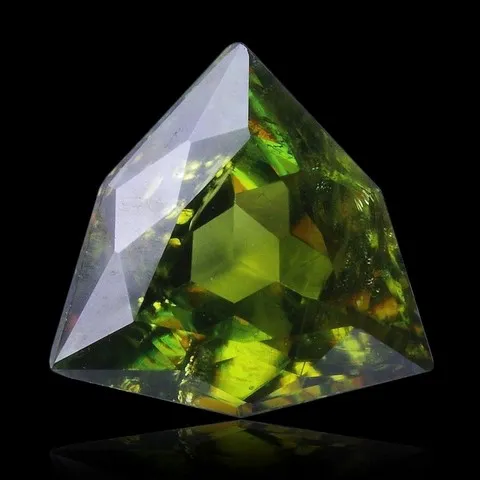TITANITE
Class : Silicates
Subclass : Nesosilicates
Crystal system : Monoclinic
Chemistry : ACaTiSiO5
Rarity : Very common
Titanite (also called sphene) is a common mineral, which develops mainly in granitic and syenitic pegmatites (syenites and nepheline syenites), in the amphibolite facies of metamorphic rocks and incidentally, but in very beautiful crystals, in alpine clefts. It owes its name to the titanium it contains. Titanite is transparent to translucent and has a strong adamantine luster. Its color is mainly yellow to green (in alpine fissures), becoming brown to black in pegmatites and metamorphic rocks. It is a mineral that occurs most often in crystals flattened on (001) with sharp edges, frequently twinned in "gutter". The most common habitus is that of a very sharp double corner (hence the origin of the name sphene), the facies is different in the alpine fissures where the crystals are frequently elongated. When it is present in large quantities, titanite is a valuable titanium ore (it contains 24% titanium). Colored transparent crystals are sometimes cut into gemstones.
Titanite in the World
Titanite in France
In France, titanite is common but rarely presents as aesthetic crystals. The micaschists of the Island of Groix (Morbihan) gave beautiful centimetric crystals. Good crystals have also been reported in the alpine fissures around Bourg d'Oisans (Isère).
Twinning and special forms
Two twins are known, one on {100} by contact and penetration, and the second is less common and lamellar on {221}.
Fakes and treatments
No fake inventories for this mineral species.
Hardness : 5 to 5.5
Density : 3.48 to 3.6
Fracture : Undetermined
Trace : White
TP : Transparent to opaque
IR : 1.843 to 2.110
Birefringence : 0.100 to 0.160
Optical character : Biaxial +
Pleochroism : Visible
Fluorescence : None
Solubility : Hydrofluoric acid and aqua regia
Magnetism : Paramagnetic
Radioactivity : None





